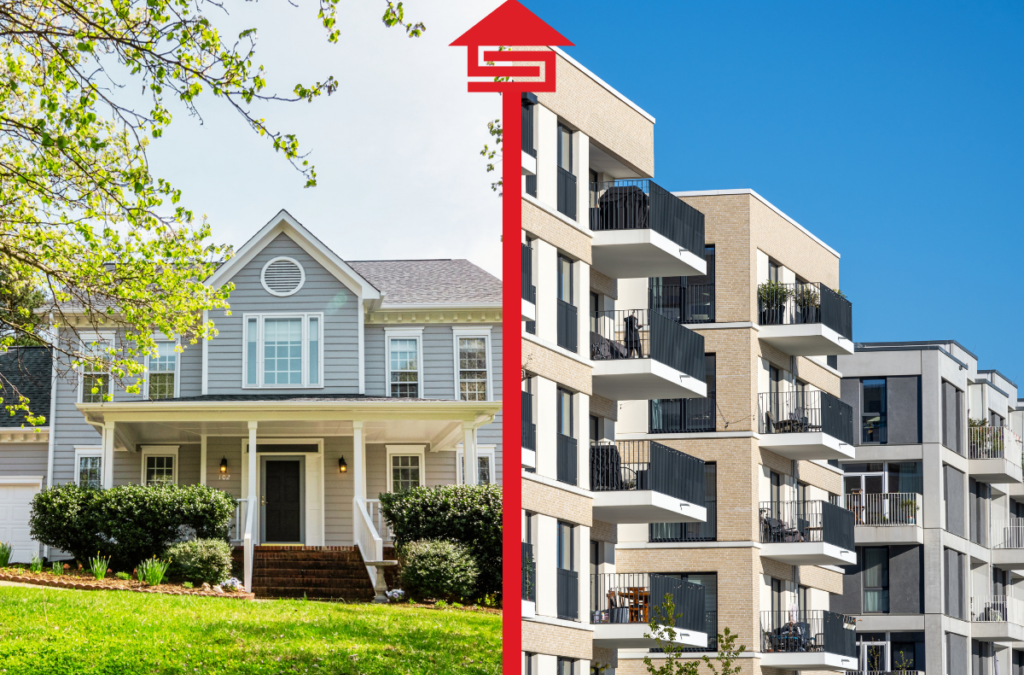
by Supreme Lending | Dec 11, 2024

As winter creeps in and the temperatures start to dip, it’s time to get your home ready to take on the chill. Think of winterizing your home as more than just another seasonal chore—it’s a proactive move to save money, improve energy efficiency, and steer clear of those unexpected (and costly) cold-weather mishaps. A little preparation now means a cozier, more comfortable home all season long. Below are some tips for cold-weather preparedness to make sure your home is winter-ready.
Seal Gaps and Insulate
- Drafts may make your heating system work overtime, leading to higher energy bills. Sealing gaps with caulk around windows and doors prevents heat from escaping and keeps your home warmer during the cold months.
- Insulating your attic and walls helps maintain a steady indoor temperature, ensuring your home stays warm without overburdening your heating system. Proper insulation may reduce heating bills significantly.
- Adding weather-stripping around doors and windows creates a tighter seal, reducing heat loss and improving energy efficiency.
Service Your Heating System
- Before the cold weather hits, consider having a professional inspect and clean your furnace. An efficient furnace ensures your home stays warm and minimizes the risk of breakdowns in the middle of winter.
- Clean air filters are crucial for optimal air quality and system performance. Changing filters regularly helps your furnace run smoothly and prevents dust and debris from circulating in your home.
- Make sure your thermostat is calibrated properly! An incorrect reading may lead to uneven heating, leaving some rooms too cold or hot.
Protect Pipes from Freezing
- Pipes in unheated areas like basements or attics are more susceptible to freezing. Wrapping them in insulation sleeves may protect them from the cold, reducing the risk of burst pipes.
- On super cold nights, allow your faucets to drip slightly (especially if pipes run through an exterior wall). Moving water is less likely to freeze, and this small step may prevent major pipe damage.
- Check for gaps around pipes, especially near walls, windows, and floors. Sealing these gaps helps keep cold air from reaching vulnerable pipes.
Clean and Inspect the Chimney & Fireplace
- Schedule a chimney cleaning. If you have and plan on using your fireplace this winter, make sure your chimney is clean. Soot and debris may build up over time and pose a fire hazard. A professional chimney sweep will clear out the buildup, helping ensure safe use.
- Check your fireplace damper. A properly functioning damper ensures that heat doesn’t escape through the chimney. Make sure it opens and closes smoothly to regulate airflow and prevent drafts.
Inspect Roof and Gutters
- Clogged gutters may lead to ice dams, which may cause water damage to your roof and walls. Remove leaves and debris to allow water to flow freely and avoid any buildup of snow or ice.
- Winter storms may be hard on your roof. Inspect your roof for missing shingles or other signs of wear. Addressing any issues now may prevent leaks and other water damage down the line.
Prepare for Snow Removal
- Be ready for snow by keeping snow shovels, ice melt, and other snow removal tools on hand. Stocking up early may save you a headache when the snow starts falling. Don’t forget to use pet-safe ice melt if you have furry friends!
- Keep walkways and driveways clear to prevent slips and falls. Regular snow removal may help avoid ice buildup and keep your family and visitors safe.
Protect Your Home’s Exterior
- Disconnect hoses and cover outdoor faucets to protect them from freezing temperatures. This may prevent damage to your plumbing and reduce the risk of burst pipes.
- Heavy snow and ice that weigh down tree branches may potentially cause damage to your roof or other parts of your home. Trimming overhanging branches now may prevent potential issues later.
Review Insurance and Emergency Plans
- Ensure that your homeowner’s insurance covers winter-related damages, such as burst pipes or roof collapse due to heavy snow. Double-check before disaster strikes!
- Assemble an emergency kit with essentials like blankets, flashlights, batteries, a first-aid kit, and non-perishable food. Having these items on hand may be a lifesaver during winter power outages or other emergencies.
Conclusion
Winterizing your home may seem like a daunting task, but taking these steps ahead of time helps ensure that your home stays warm, safe, and efficient throughout those colder months.
We’re here to support you in every aspect of homeownership at Supreme Lending. Whether you’re exploring loan options for home improvements, considering refinancing* to free up funds for winter upgrades, or have general loan-related questions, our team is ready to assist. Let’s work together to make your homeownership journey as secure and comfortable as possible this winter. Reach out to us today!
*By refinancing an existing loan, total finance charges may be higher over the life of the loan.

by Supreme Lending | Oct 10, 2024
Discover the Key Differences Between a Condo vs. Single-Family Home

So you’ve finally decided to end the debate of renting vs. owning a home and pull the trigger on your homebuying journey. Congratulations! The next big question is deciding what kind of property you want to purchase—a condo vs. single-family home. Both options offer the potential to build equity, but the right choice comes down to your lifestyle, budget, and long-term goals.
To help you decide, here’s an overview the pros and cons of each option and how Supreme Lending may help you finance your dream home, whether it’s a condo or a single-family house.
Pros & Cons of Buying a Condo
Pros
- Lower Maintenance. One of the biggest benefits of condo living is that most exterior maintenance and landscaping are handled for you by the Homeowners Association (HOA). If you’re looking for a lower-maintenance lifestyle where you can focus on enjoying your space without the hassle of yard work or home repairs, you may want to consider a condo.
- Amenities. Many condo communities offer shared amenities such as pools, gyms, and clubhouses. This can provide luxurious perks without the extra cost of maintaining the amenities yourself.
- Affordability. In general, condos may be more affordable than single-family homes. For this reason, they are a great option for first-time homebuyers or those looking to downsize. If you’re trying to buy in a competitive housing market, a condo may offer a more budget-friendly option to open the door to homeownership.
- Location. Condos are often located in urban areas or desirable neighborhoods with easy access to dining, shopping, and public transportation. If you enjoy the vibrancy and convenience of city living, a condo can put you right in the action.
Cons
- HOA Fees. While HOAs manage the maintenance of shared spaces and amenities, that comes with a monthly cost. These fees can add up, and it’s important to factor them into your budget when considering the overall homebuying costs.
- Limited Privacy. Since condos are often in multi-unit buildings, you’ll likely be sharing a wall with neighbors. If privacy and quiet are important to you, this is something to consider.
- HOA Restrictions. HOAs typically have rules regarding what you can and cannot do with your unit, from the color of your front door to controlling whether you can rent it out. While these rules are put in place to help maintain the property’s value, they may also limit your freedom.
Pros & Cons of Buying a Single-Family Home
Pros
- More Space. Single-family homes typically offer more living space, both indoors and out. If you need room for a growing family, pets, or hobbies, or simply enjoy having a larger yard, a house may give you the space and flexibility you need.
- Privacy. Unlike condos, single-family homes can provide more privacy since you wouldn’t be sharing a wall with your neighbors. If peace and quiet are priorities, a standalone house may be your answer.
- Freedom to Personalize. As a single-family homeowner without an HOA, you have the freedom to make changes and renovations to your home. Want to build a deck, repaint your exterior, or add on more square footage? You would have the flexibility to do so.
- Suburban and Rural Living. Many single-family homes are located in suburban or rural areas. This may offer a quieter, more relaxed lifestyle away from the hustle and bustle of city life.
Cons
- Maintenance Responsibilities. With the freedom of owning a standalone property comes the responsibility for home maintenance, repairs, and upkeep. From mowing the lawn to fixing a leaky roof, you’ll be responsible for keeping everything in good condition.
- Higher Cost. Oftentimes, single-family homes may be more expensive than condos, both in terms of purchase price and ongoing costs such as property taxes, insurance, and utilities. Be sure to keep those additional costs in mind when deciding to buy a condo vs. a single-family home.
- Location. While one of the perks of single-family living is being in a more suburban or rural area, that also means you may be father away from city centers. This could result in a longer commute or less access to urban amenities.
How Do You Decide?
When choosing between a condo vs. a house, here are four helpful considerations:
- Lifestyle. Do you prefer a low-maintenance, lock-and-leave lifestyle with shared amenities? Or do you value privacy and space to personalize your property? You daily routine and personal preferences should guide your decision.
- Budget. While condos may have lower upfront costs, you’ll need to factor in HOA fees. On the other hand, single-family homes may require more financial investment in terms of ongoing maintenance.
- Location, Location, Location. Think about where you want to live. Do you prefer the convenience of urban life? Or do you dream of a suburban or rural retreat? The location has a direct impact on your lifestyle and commuting needs.
- Long-Term Goals. If you’re planning to grow your family, need extra space for hobbies, or want the freedom to make home improvements, a single-family property may make more sense. But if convenience and lower maintenance are calling your name, a condo may be the right fit.
The Benefits of Homeownership – No Matter What You Choose
Whether you opt for a condo or a standalone home, you’ll still enjoy all that homeownership has to offer. Owning your own place may give you the potential to build equity and financial stability. You’ll also have the flexibility to create a space that truly reflects your personality and lifestyle. Plus, homeownership has the potential to provide long-term rewards, as your property may appreciate in value over time.
Supreme Lending Has You Covered
Ranked as a 2024 top 15 retail lender in the country by Scotsman Guide, Supreme Lending has a wide range of mortgage options to help put people into homes—whether it’s a condo or single-family. Whatever your dream of homeownership may look like, we’re here to help with your home financing needs.
Ready to get started? Reach out to our team today!
Related Articles:

by Supreme Lending | Sep 30, 2024

Buying a home is a major milestone, and while most prospective buyers are focused on saving for the down payment, there are additional homebuying costs to consider. From closing costs to ongoing home maintenance expenses, it’s important to understand the costs beyond the down payment. Let’s dive into those homebuying costs so you can be well prepared.
Down Payment: The First Major Cost
The down payment is often the largest upfront cost when buying a home. The down payment requirements depend on the type of loan to determine what you may qualify for.
- Conventional loans typically require at least 5% for eligible borrowers. For first-time homebuyers, the minimum requirement can be as low as 3%.
- FHA loans require as little as 3.5% down, making them a popular choice for borrowers looking for more flexible guidelines.
- VA and USDA loans offer no down payment requirement for eligible military veterans, active military, or buyers in defined rural areas.
Plus, there are several down payment assistance programs available to help more people achieve their dream of homeownership. While the down payment is a key part of purchasing a home, it’s not the only cost to keep in mind.
Closing Costs: Hidden Homebuying Fees
Beyond the down payment, closing costs are another significant upfront expense buyers must account for. These are fees and expenses necessary to finalize your home purchase and close the loan. Closing costs typically range from 2% to 6% of the home’s purchase price. Here’s a breakdown of common closing costs:
- Loan origination fee is charged by your lender for processing your mortgage.
- Appraisal fee covers the cost of having your home professionally appraised to determine its market value.
- Home inspection fee is paid to inspect the home for any necessary repairs or safety hazards.
- Title insurance and search fees ensure the property’s title is clear of any disputes or liens.
- Escrow fee is charged by the third party handling the closing process.
- Property taxes and homeowners insurance are typically prepaid for a portion of the costs at closing so they’re included in your mortgage escrow account.
Ongoing Costs of Homeownership
After closing on your mortgage, owning a home comes with ongoing expenses that many new buyers often overlook. These homebuying costs are essential to consider when planning for the long-term.
- Utilities include monthly bills such as electricity, gas, water, and internet. These are widely dependent on the size and location of your home.
- Landscaping and yard maintenance, whether you hire a service or handle it by yourself, keeping up with lawn care, tree trimming, and other outdoor maintenance can add up.
- Homeowners Association (HOA) fees are required when your property is in a community with an HOA. These fees may be monthly or annual and cover community maintenance and amenities.
- Property taxes are ongoing local government taxes based on the assessed value of your home. Property taxes may increase over time, so review your tax bills carefully.
- Homeowners and mortgage insurance are often required. Homeowners insurance helps protect the home in the event of potential damages, while mortgage insurance protects the lender in the event of a loan default.
- Ongoing maintenance and repairs will occur over time, from replacing appliances to fixing the roof or plumbing. It’s smart to set aside funds for common home upkeep expenses to avoid hidden costs surprising you.
What’s Next?
We hope these additional homebuying costs are not so hidden anymore! The journey to homeownership comes with several financial considerations beyond the down payment. By understanding these homebuying costs, you can be prepared to buy with confidence.
If you’re ready to explore your mortgage options, contact Supreme Lending today. We’re here to help guide you through the loan process and beyond.






